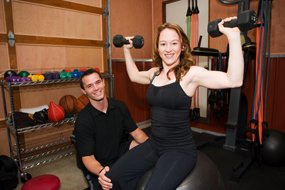- Home
- Natural Osteoporosis Treatment
- Exercises for Osteoporosis
Exercises for Osteoporosis
an Essential Part of Your
Natural Osteoporosis Treatment
What are the best exercises for osteoporosis? Exercises that increase bone density, strength and balance are key. Weight bearing exercises put stress on the bones. The good news is that bone density and strength can be increased at any age. Of course it's best to choose exercises that you enjoy or you can learn to enjoy or your motivation may likely wane.
After age 40 we lose muscle mass, which in turn slows down our metabolic rate and weakens bones. Ben Hurley, a professor of exercise physiology at the University of Maryland states that Women in their 40s and men in their 60s lose muscle strength at a rate of about 12 % per decade. But you can increase muscle mass quite quickly. Just 2 months of strength-building can reverse two decades of a typical person's muscle loss and increase strength by 40%! ¹
The best osteoporosis exercise program includes:
- Strength training
- Weight bearing aerobic exercise
- High Impact activities
- Exercises for balance
- Exercises for flexibility
 |
High impact sports include tennis, volleyball, basketball, jumping rope, jumping jacks, etc. Proceed with caution though, as these, as well as some weight bearing aerobic activities, can be hard on your joints. If you know you have osteoporosis you might skip these until you increase your bone density. Also, those with osteoporosis should avoid exercises that have you bend forward or backward. |
Strength Training:
Muscles and bones get stronger by doing weight bearing exercises. To determine which weight is right for you the weight should be heavy enough that you can only lift it 8 to 12 times before you need to rest. If the weight is so heavy that you can't do more than 5 or 6 repetitions you can injure your joints and other tissues that surround them.
Of course the ideal weight will change over time. As you increase strength you will be able to increase your weights. The American College of Sports Medicine recommends two to three sessions per week, leaving one day in between your sessions.
Your exercises for osteoporosis should entail short periods of exercises with heavier weights that produce more new bone, rather than long term exercises with lighter weights. ³ So make sure your weights are heavy enough.
Always start your strength training program with a qualified professional who designs a personal program for you.
Strength training exercise suggestions:
- Seated overhead press
- Forward fly
- Wrist curls
- Abdominal exercises
- Side leg raises with weights
- Ankle exercises, standing toe and calf raises
- Back extensions, lying on your abdomen
- Chest presses, lying on your back
- Bicep curls with rotations with weights
- Front lunge
Some stretches to do:
- Hamstring stretches
- Shoulder stretches
- Upper back - pull elbows back
- Tree posture
Combine these osteoporosis exercises with your
osteoporosis diet and nutritional supplements to complete your natural osteoporosis treatment.
References:
1. Shardt, David. Saving Muscle Nutrition Action, Health Letter, (Toronto, Canada) Volume 54, Number 3, April 2007.
2. Nelson, E. Miriam. Ph.D. Strong Women, Strong Bones (New York: G.P.Putnam'S Sons, 2000) 133-213.
3. Brown, E. Susan, Ph.D. Better Bones, Better Body (Lincolnwood, Illinois: Keats Publishing, 2000)305-325.
